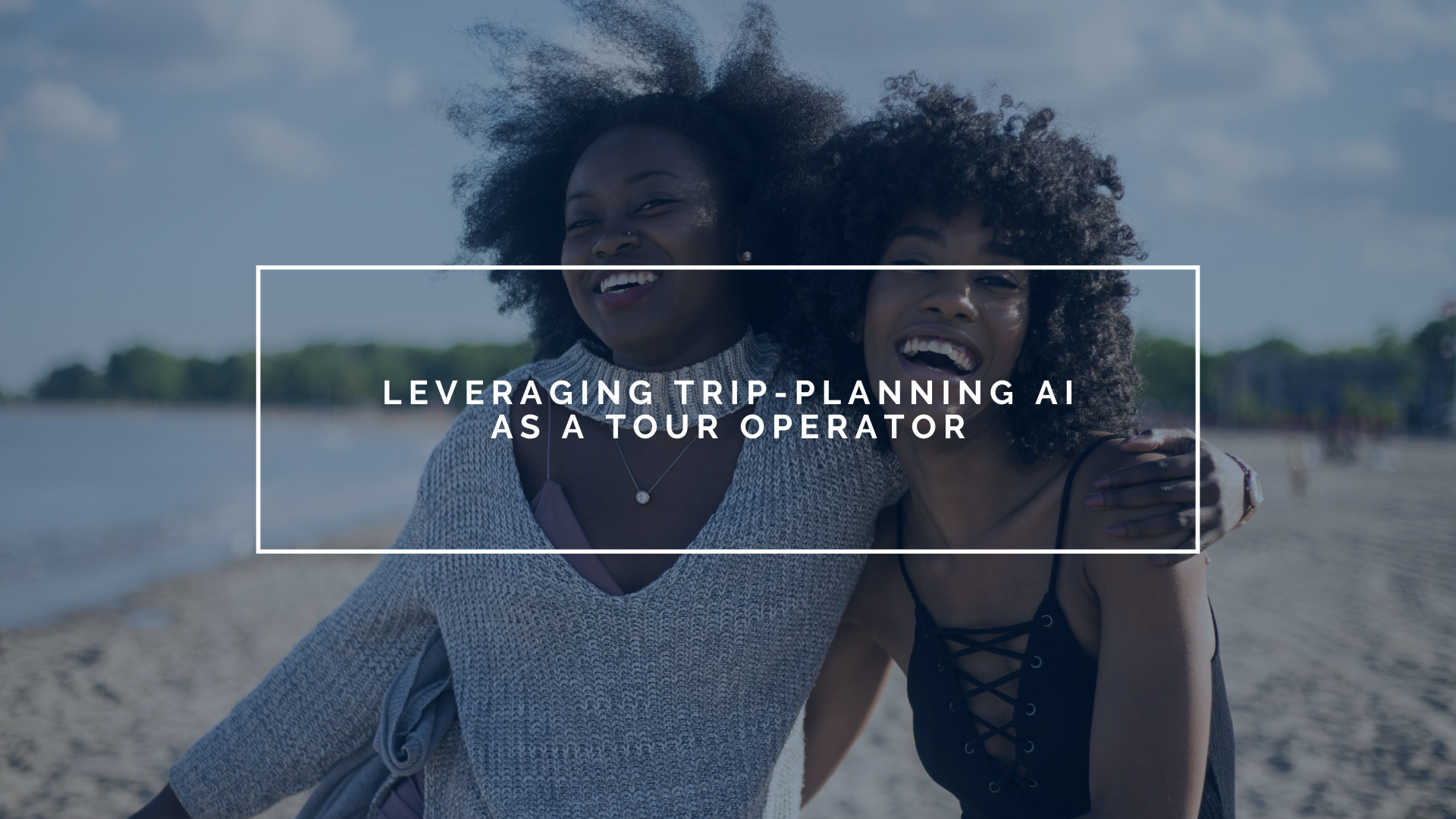There are so many ways to plan a trip. Booking websites, travel agents, Pinterest blogs, trip-planning social videos… the list goes on.
But there’s a new trip-planning strategy in town, and it out-performs other strategies convenience, time-saving, affordability and customization. This technology is, of course, trip-planning AI. It’s no wonder that trip-planning AI is a fast-growing sector of the AI movement, and potential visitors across demographics are excited to put this new tech to the test on their next vacation.
We have entered the first frontier of utilizing machine-learning technology for trip recommendations over human advice and tips. What does that mean for adventure companies? Let’s talk about it!

Why Are People Using AI for Trip Planning?
There are several reasons why people are experimenting with AI trip planning. Here are a few:
Immediate results. AI trip planning doesn’t need research time, contact forms, or even a “Hmmm… let me think about that.” You type in your questions or parameters, and AI will immediately provide some tips, itineraries, or recommendations.
It’s backed by millions of pages of online research(almost). Gone are the times when you had to spend hours scouring multiple blog posts and travel review websites to gather all of the best information for an area. AI can use millions of pages of reviews, stories, trip ideas and more to find popular advice and recommendations for your specific trip needs.
It’s customizable. Especially with chatbots like Chat GPT, you can go back and forth and tailor your itinerary with AI. Chat GPT can create an initial itinerary and you can respond to remove the things you don’t want and add more of what you do.
Limitations
Sounds too good to be true? That’s because, at least for now, it is. As AI grows and learns, there will be some kinks to work through and weaknesses to be aware of.
It is often inaccurate. Don’t trust all of the info that AI generates, and it’s always a good idea for individuals to check the work of AI.
AI doesn’t have a human touch. It can mimic the human touch to an extent, but not as far as to really convey the emotional draw of an area. People will almost always trust the opinion of someone who has already visited an area over that of AI.
Often, the transportation information can be off or unrealistic for the average traveler. AI can add too much transportation time to fit in all of the tourist sights of an area without factoring in relaxation.
Your customers’ content may contain perspectives or pieces of value you haven’t considered or prioritized yet.
You know your experience inside and out. However, your customers may have a better handle on how that experience can fit into a traveler’s or planner’s day. For example, let’s look at ATV tours. One of your customers planned and posted about a 9-year-old birthday party with ATVs, matching T-shirts, a themed cake, and desert-themed games. You didn’t develop these ideas, but the event inspired other groups to try out the ATV-themed birthday.
You don’t have to create the content yourself!
Best of all, you aren’t spending time, money and resources for non-sponsored UGC! People make these videos, quotes, and images because they are delighted with your experience and want to share it with their community.

What AI do people use for trip planning?
We all know that the mother of all AI, Chat GPT, can help us with itineraries and trip planning. On top of that, AI platforms specific to trip planning are popping up left and right. Here are some of the tools people are using for planning an adventure.
- Generative Google AI: for those that have the new generative AI update, you can use Google Generative AI to learn quick facts about areas, tour operator options, and top-level info about the areas you’re researching.
- Chat GPT: Chat GPT is an option perfect for when you are in itinerary-planning mode for the overall trip. It can create a day-by-day or even hour-by-hour plan for your experience, including what to do and where to go and options of where to stay.
- Niche AI trip-planning platforms are great for planning trips within specific parameters. For example, Adventure Genie is a great AI trip-planning choice specifically for RV road trips in the United States.
- Wonderplan AI: using AI that is specific to trip-planning also offers more services tailored to finding experiences, like real-time itinerary updates, customized recommendations, and offline access.

What does AI Trip Planning Mean for Destination and Tour Companies?
Potential guests across demographics are using AI to plan trips. What does that mean for companies in the travel and tourism industry?
Website Traffic May Decline
Because users will be researching based on videos and AI over specific websites, you may see a dip in website traffic. Don’t worry too much; it just may mean that the first couple of steps of the purchase funnel are taken before they ever enter your website. They will still need to book the trip.
A Boost of Awareness for Destination Activities and Tour Ideas
When creating a vacation itinerary, AI will include suggestions like “take a food tour of this neighborhood”, “try tubing the local river in this especially scenic section” and other specific activity recommendations that customers may not have been considering or had the background to find. AI itineraries don’t usually include specific businesses or booking direction, so it does fall on personal research to find a tour company once a potential customer is interested.
There Will Be Another Frontier of Competition in AI Results
Competition for the first few Google results is still alive and well, but AI is a new opportunity to rank as a top recommendation. When someone asks AI “what to do in the Ozarks,” it will shoot out some recommendations – and only a few business recommendations will be mentioned in responses.
AI May Favor Established Companies Over New Ones
Because trip-planning AI bases its recommendations on online content, businesses with more online content will have a better chance of showing up in AI results. Newer companies may have to work hard to build the content necessary to appear on AI platforms. The same concept may be relevant for companies that don’t regularly create or update content. Because AI like Chat GPT only has access to older data (it used to be from 2021, and now the free version can leverage information up until late 2023), brand-new businesses will have to wait for future updates before it’s possible for AI to recognize their online presence.
How to Build Your Presence On AI Trip Planning Platforms
Fortunately or unfortunately, there are no surprises or secret recipes here. The same things that help you rank well in search engines will help you show up on trip planning AI. Here are a few best practices that can maximize your chances of getting your information pop up in AI results.
- Follow SEO best practices. From keyword strategy to technical SEO updates, a robust SEO strategy will help you appear in AI results as well as SERPs.
Create itinerary pages on your website. The more trip planning you include in your content, the easier it is for Generative Google AI to pull your information into a snippet. - Create a clear categorization of site content. Structured data and scheme markup is critical to having organized information in the front end of your website as well as the backend. This helps Google easily sift through and find relevant information to share.
- Write question/answer, FAQ, and succinct copy. Google AI and other forms of AI prefer this copywriting style, because it directly complements most query styles. When writing content on a topic or question, we recommend answering short for Google and then elaborating for the reader.
- Generate great reviews. Review platforms also play a role with AI research. Having a large amount of positive reviews is a green flag for AI to highlight your activity.
- Have a consistent and active online and social presence. The more content you add to your digital presence, the more AI has to pull from. This can be videos, social posts, guest articles, blog posts, new web pages, and more.
Don’t miss out on optimizing your business for this new technology!
Harness the power of AI to show up for potential customers planning their next adventure.

